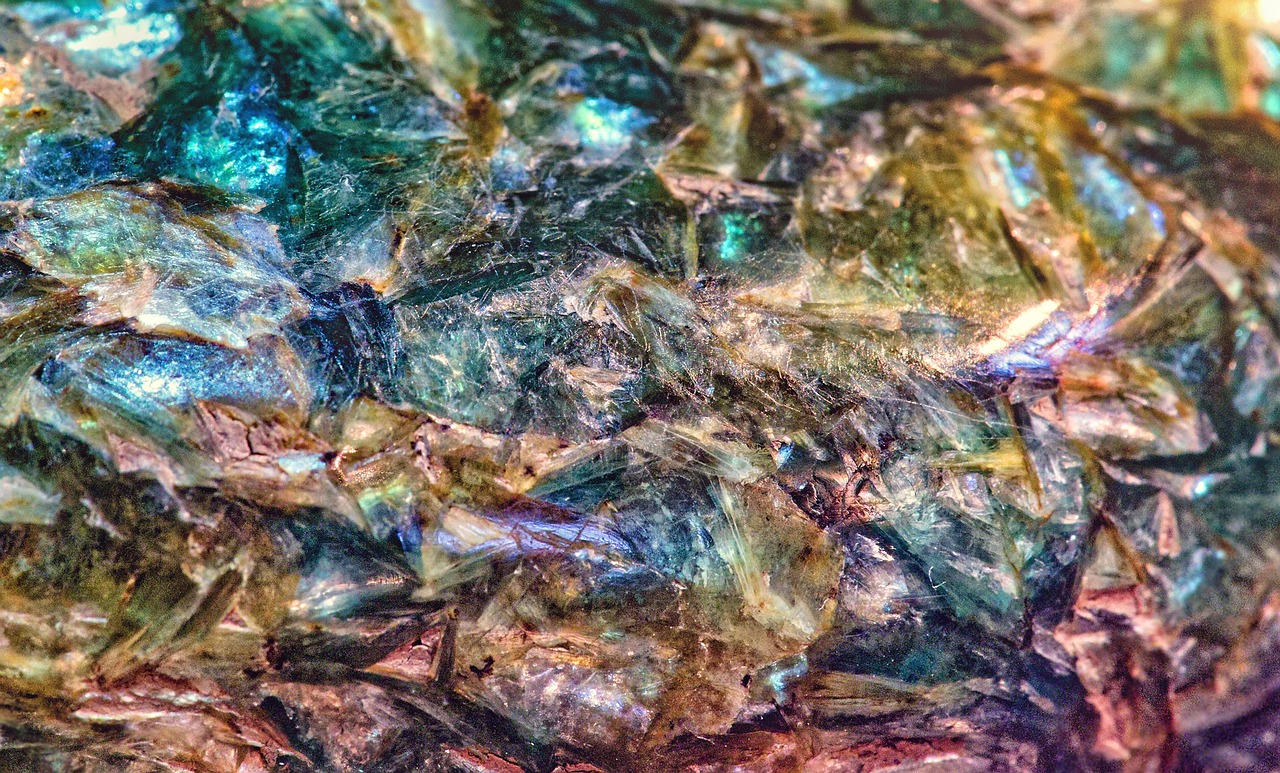Fluorite, a captivating mineral known for its dazzling array of colors and remarkable properties, plays a significant role in numerous industrial processes and everyday products. Referred to as fluorite in its mineral form and fluorspar when extracted for various applications, this mineral has been a vital element in human civilization for centuries. Its applications span from metallurgy and optical technology to oral hygiene. In this extensive exploration, we will delve into the multifaceted uses of fluorite and uncover the fascinating journey from mine to everyday products.

1. Fluorite: A Mineral of Multifarious Colors
Fluorite, scientifically known as calcium fluoride (CaF2), is renowned for its diverse and vibrant colors. Its name is derived from the Latin word “fluere,” meaning “to flow,” owing to its use as a flux in metallurgy, as we shall later explore. This mineral occurs in a variety of shades, including purple, green, blue, yellow, and more, often appearing as cubic crystals or in massive form. But what truly makes fluorite remarkable is not just its aesthetic appeal but its wide-ranging applications across several industries.
2. Fluorspar: From the Earth’s Depths to Industrial Use
Fluorspar, the mined product derived from fluorite, has been harnessed for centuries to enhance industrial processes. One of its earliest and most crucial applications is in metallurgy, particularly in the smelting of metals like iron and aluminum. The use of fluorspar as a flux is instrumental in facilitating the extraction of pure metals, a process that has significantly advanced the field of metallurgy.
3. A Flux for Purity: Fluorspar in Metallurgy
3.1. The Role of Flux in Smelting
The use of fluorspar as a flux in metallurgy is a practice dating back thousands of years. A flux is a substance that is added to a metallurgical process to lower the melting point of impurities and help them separate from the desired metal. In the smelting of metals, the addition of fluorspar serves to enhance the separation of impurities, ensuring a more refined and pure end product.
3.2. Smelting of Iron and Fluorspar
One of the earliest uses of fluorspar in metallurgy was in the smelting of iron. Iron ore typically contains various impurities like silica, alumina, and other non-metallic substances. When iron ore is heated to high temperatures in a blast furnace, these impurities form slag. The addition of fluorspar helps the slag melt more readily, reducing its viscosity and allowing it to flow more easily. This facilitates the removal of impurities from the molten iron, resulting in a higher-quality iron product.
3.3. Aluminum Smelting and Fluorspar
Fluorspar’s role in aluminum smelting is equally significant. Aluminum is typically extracted from bauxite ore through a process called the Hall-Héroult process. In this process, alumina (aluminum oxide) is dissolved in a molten electrolyte, and an electric current is passed through it to separate the aluminum from oxygen. The addition of fluorspar to the aluminum smelting process helps improve its efficiency by lowering the melting point of alumina and enhancing conductivity.
4. Beyond Metallurgy: Fluorspar in Industrial Applications
Fluorspar’s contributions extend beyond metallurgy, reaching into diverse industrial sectors.
4.1. Optical Lenses: A Crystal Clear Connection
The optical industry has long relied on fluorite for its exceptional optical properties. The mineral’s low dispersion and high refractive index make it an excellent material for manufacturing optical lenses. The use of fluorite in optical lenses results in higher clarity and less chromatic aberration, enhancing the performance of cameras, telescopes, and microscopes. The unique properties of fluorite contribute to the production of superior quality lenses used in a wide range of optical devices.
4.2. Fluoride in Toothpaste: The Smile-Saving Mineral
Fluoride, a compound derived from fluorite, has made a substantial impact on oral hygiene. This compound is an essential component in toothpaste, serving to strengthen tooth enamel and prevent tooth decay. By remineralizing weakened enamel and inhibiting the growth of harmful bacteria, fluoride has become a cornerstone in maintaining good dental health. Thus, every time you squeeze toothpaste onto your brush, you can thank fluorite for helping to protect your smile.
5. The Geological Treasures of Fluorite
Fluorite is not only renowned for its industrial applications but also treasured by geologists and mineral enthusiasts. Its captivating colors and diverse crystal formations have made it a sought-after specimen in mineral collections. Its occurrence in a variety of geological settings has intrigued scientists and hobbyists alike.
5.1. Geological Formation of Fluorite
Fluorite can be found in a wide range of geological settings. It commonly occurs in hydrothermal veins, where hot water saturated with minerals flows through fractures in the Earth’s crust, depositing fluorite crystals along with other minerals. This geological process results in the formation of beautiful, well-formed crystals.
5.2. Mining Fluorite: A Complex Endeavor
Mining fluorspar can be a challenging endeavor due to the varied geological conditions in which it is found. The process involves the extraction of fluorite-rich ore from underground mines, which can be both open pit and underground. Subsequently, the ore is processed to extract fluorspar for industrial applications. The mining and processing of fluorspar require careful planning and adherence to environmental regulations to minimize its impact on the surrounding ecosystem.
6. Environmental and Health Considerations
The widespread use of fluorite and its derivatives, particularly fluoride in toothpaste, raises concerns about potential environmental and health impacts.
6.1. Environmental Impact of Fluorite Mining
The mining of fluorite ore can have environmental consequences, particularly when not managed responsibly. The extraction process can lead to habitat disruption, soil and water contamination, and deforestation. To mitigate these impacts, mining companies are encouraged to implement sustainable practices and engage in environmental rehabilitation efforts.
6.2. Fluoride in Toothpaste: A Delicate Balance
While fluoride in toothpaste plays a crucial role in preventing tooth decay, it is essential to use it judiciously. Excessive fluoride consumption, either through toothpaste ingestion or drinking water, can lead to a condition known as dental fluorosis, which affects the appearance and strength of teeth. Therefore, public health authorities regulate the fluoridation of drinking water to ensure it remains within safe limits.
7. The Future of Fluorspar: Emerging Applications
The unique properties of fluorite and fluorspar continue to find new applications as technology and research advance.
7.1. Rare Earth Element Extraction
Rare earth elements (REEs) are essential components of various high-tech products, including electronics, magnets, and clean energy technologies. Fluorspar plays a significant role in the extraction of REEs from ore deposits. The addition of fluorspar as a flux helps improve the efficiency of REE processing, making it a valuable mineral in the context of emerging green technologies.
7.2. Lithium-ion Batteries and Energy Storage
With the growing demand for energy storage solutions and the rise of electric vehicles, fluorspar is finding a place in the manufacturing of lithium-ion batteries. It is used as a flux in the production of lithium carbonate, a key component in these batteries, contributing to the development of sustainable and efficient energy storage systems.
8. Conclusion
In summary, fluorite, a mineral known for its vibrant colors and exceptional properties, takes on various forms and applications in our modern world. Mined as fluorspar, it has historically played a critical role in metallurgy, serving as a flux in the smelting of metals like iron and aluminum. Beyond metallurgy, its contributions to optical technology and oral hygiene, with fluoride derived from fluorite, have improved our quality of life.
This mineral’s geological treasures, admired by collectors and scientists alike, have fascinated generations, while the responsible mining and processing of fluorspar must be balanced with environmental considerations. As technology advances, emerging applications in rare earth element extraction and lithium-ion batteries illustrate the ongoing relevance of fluorspar in our ever-evolving world.
From its origins in the Earth’s depths to the products we use daily, fluorspar is a testament to the profound influence of minerals on our civilization. As we continue to explore and harness the potential of this remarkable mineral, we ensure that it remains a valuable and sustainable resource for generations to come.





